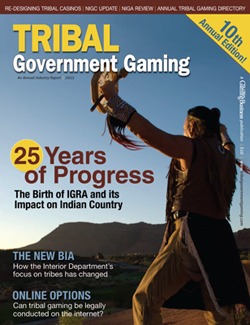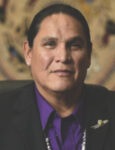
On October 17, 1988, when Congress passed the Indian Gaming Regulatory Act (IGRA), it was not possible to predict the profound socioeconomic and cultural changes that would occur on and near American Indian reservations in the United States due to gaming on tribal lands.
Tribal governments have invested gaming revenues wisely and continue to grow out of poverty while making substantial capital investments in tribal communities as well. While the income gap between reservations and the rest of the United States remains large, tribal governments have used the opportunity of tribal government gaming to narrow the gap. By now, it is clear to those both in and outside of Indian Country that the two major policy mandates of the 1988 IGRA (to stimulate economic development and to strengthen tribal governments) have been achieved.
While the impacts of tribal gaming are well-known to the tribal governments and communities themselves, I have had the privilege of working with tribal leaders and organizations to help document, articulate and disseminate the cultural, social and economic outcomes related to gaming for nearly 20 years. For the past five years, as chairwoman of the Sycuan Institute on Tribal Gaming at San Diego State University, I have also had the honor of directing much-needed funding to support important research on tribal government gaming’s profound social and economic impacts on communities and cultures.
While there are numerous stakeholders with an interest in tribal gaming’s impacts, including Congress, state governments and local communities, it is the tribes’ commitment to research about tribal government gaming that stands out in the past 25 years. Rather than allow their stories to be told by outside interests that may misrepresent or underestimate the complexities of tribal gaming’s effects on communities, tribal governments and organizations have taken the lead in building a research agenda that recognizes that tribal gaming research is still an emerging field that requires interdisciplinary and creative methodologies, including qualitative methods capable of analyzing the unique policy goals and intended social returns embedded in IGRA.
While tribal governments have always been gifted at telling their own stories, the first major political impetus for creating a coordinated national research agenda on tribal government gaming’s impacts was in response to public hearings being held by the National Gambling Impact Study Commission in 1998. At that time, the NGISC’s political strategy was to pit the various gambling industry segments against one other in order to develop a continuum of “good” gambling and “bad” gambling in the United States. As a political maneuver, tribal governments were essentially positioned by the commission as a subset of the larger commercial casino gambling industry.
Since the NGISC research agenda consisted of directing the same policy questions at each industry segment (such as the relationship between commercial casinos or tribal government gambling and certain social or economic outcomes), this approach to evaluating tribal government gaming revealed that the impacts from tribal casinos are similar to those of the commercial casino gambling industry, with a few important exceptions related to the unique policy and social environments that tribal governments manage.
In the end, the NGISC acknowledged that “the gambling industry is far from monolithic,” and that each segment of the gambling industry “has its own distinct set of issues, communities of interest and balance sheets of assets and liabilities.” With this NGISC finding as a backdrop, tribal governments began to differentiate themselves along these important dimensions.
The National Indian Gaming Association
After the release of the NGISC’s final report in 1999, the National Indian Gaming Association created the first National Indian Gaming Library and Resource Center to serve as a clearinghouse of information about the tribal government gaming industry, including its unique regulatory structure and the targeted uses of tribal gaming revenues under IGRA, among other key features.
The NIGA Library houses the first national database of tribal gaming studies, and represents a commitment to telling the story of tribal government gaming from the tribal perspective.
As part of that commitment, NIGA funded the first national impact study of tribal government gaming at Harvard’s Kennedy School of Government in 2001. Comparing the 1990 and 2000 Census data, this national databook captured the impacts of the first decade of gaming under IGRA and documented a profound turnaround in Indian Country. Authored by Jonathan Taylor and Joe Kalt, this databook compares gaming and non-gaming areas to each other and to the U.S. as a whole.
The data on 15 measures ranging from income and poverty to employment and housing conditions indicated that tribal governments made substantial gains during the 1990s but that large gaps remained. The authors put the remarkable improvements in Indian Country between 1990 and 2000 into historical perspective by reminding those who might see tribal gaming as a universal remedy that much remains to be done to close the gap. Indeed, they concluded at that time that, “If U.S. and on-reservation Indian per-capita incomes were to continue to grow at their 1990s rates, it would take half a century for tribes to catch up.”

California Nations Indian Gaming Association
While the Harvard databook provided a critical exploration of the macro-level impacts of IGRA and demonstrated that self-determination policy produced significant gains across Indian Country, tribal governments needed local-level data to highlight the particular benefits of locating casino gaming on tribal lands. In 2005, the Pechanga Band of Luiseño Indians and the California Nations Indian Gaming Association provided funding for researchers at the University of California-Riverside (UCR) to compare changes in key indicators of well-being between the 1990 and 2000 U.S. Census across tribal governments in California.
These tract-level findings demonstrated that gaming operations had beneficial effects on tribes, and also had strong economic and social benefits in the form of “spillover effects” that reached beyond the reservations in California. These consequences of tribal government gaming were linked to two identifiable features of the casino enterprises themselves: 1) the fact that they are owned by tribal governments; and 2) the fact that they must be located on existing tribal lands.
By focusing on the effects of tribal gaming on localities, the UCR team revealed that since citizens of Indian nations are more likely to undertake gaming from a relatively disadvantaged social position vis-à-vis non-Indians, gaming can bring benefits to Indian nations and their neighbors that are more pronounced than they would be in a less disadvantaged region. Additionally, since tribal government gaming is most likely to emerge in areas with depressed economies, the benefits of tribal government gaming spread beyond the tribal community into the surrounding region.
The Sycuan Institute on Tribal Gaming
On the strength of these findings and in order to institutionalize the ability for Indian Country to produce meaningful research on the effects of tribal government gaming, the Sycuan Band of the Kumeyaay Nation endowed the Sycuan Institute on Tribal Gaming (SITG) at San Diego State University in 2005.
In addition to offering the nation’s first four-year degree in tribal casino operations management, the SITG provides funding for independent, peer-reviewed scientific research on tribal government gaming. The focus of Sycuan Institute research funding reflects the priorities of tribal nations themselves, with an emphasis on the social and cultural impacts of tribal gaming, best practices in tribal responsible gaming, the role of tribal political influence and the nature and influence of tribal gaming employment.
Since its first grant in 2006, the Sycuan Institute has supported research at more than a dozen academic departments at 10 universities. Sycuan-funded research has been published in multiple books and publications and has been presented at numerous industry and academic events.
Thanks to the Sycuan Institute, we now have a more sophisticated understanding of the ways tribal gaming operators interact with guests who exhibit disordered gambling behaviors. We have more evidence of the remarkable gains in education and cultural revitalization that government-owned casino revenues can make possible. Additionally, we have a framework for developing cultural programs to support tribal identity and education, and a greater understanding of the complex cultural processes involved in the creation of contemporary tribal cultures and identity.
Twenty-Five Years of IGRA Impacts
In addition to the important cultural research already completed, in 2012 the SITG funded the extension of prior research on socioeconomic change produced by research teams at Harvard and UCR. The recent release of the 2010 American Community Survey (ACS) by the U.S. Census Bureau provides an opportunity for data gathering and analysis to update and build upon work examining change between the 1990 and 2000 U.S. Censuses and the 2006-2010 American Community Survey.
This opportunity allows an evaluation of a second decade of social and economic change under IGRA, including the first decade of compacted gaming in California. The first Harvard data book determined that in the 1990s, economic growth on Indian reservations outpaced the United States’ income growth by a factor of three. Data from the ACS indicate that the pace of reservation economic growth slowed between 2000 and 2010, but that it still outpaced U.S. growth. The income gap between reservations and the rest of the United States remains large, but American Indians continued in the 2000s to close it.
The study, led by economists Jonathan Taylor and Randy Akee, examines this and other trends in income, employment, housing and education over the period of 2000-2010 and compares them to trends in the prior decade. It also examines off-reservation changes in income and employment.
One of the early and important findings in the national dataset reflects the larger economic challenges of the U.S. economy in the last decade. Real per-capita income, defined as all income divided by the number of people, decreased by 6 percent across the United States. While the recession depressed national incomes, growth in American Indian income between 5 percent and 6 percent helped close the gap. While the variance in the last decade suggests that tribes are “catching up,” it is critical to note that tribal per-capita income is still less than half of the Total U.S.-All Races level.

Impacts on California Localities
The Sycuan Institute has also funded an update to the UCR study on local impacts of tribal government gaming using the ACS from 2006 to 2010. Just as UCR found for the first decade of pre-compacted California tribal gaming, there are significant gains for American Indians on reservations (with and without gaming) and those who live nearby (in this case, within 10 miles). For example, during the first decade of compacted tribal gaming in California, American Indian per-capita income grew to $18,371 and $16,979 on California reservations with and without casinos, respectively. This growth among American Indian populations helped close the gap with the U.S. average ($26,648), although these gains may arguably be less due to gaming’s growth than due to the drop in national income associated with the recession.

Both the UCR and Sycuan studies also demonstrate that the spillover effects of tribal government gaming in California for the last two decades are revealed in census tracts within 10 miles of California reservations with gaming. In communities near California reservations with gaming, income for Californians of all ethnicities rose by more in the 1990s and fell by less in the 2000s than it did for those tracts that were more than 10 miles from a reservation with gaming.
Tracts near tribal casinos continue to display lower average income, but the gap is closing. For example, incomes for communities within 10 miles of a reservation with gaming grew six times more than those more than 10 miles away. These impacts result from the fact that most American Indian reservations in California, even the more prosperous ones, are generally located in the poorest counties and tracts in the state.

Stories To Be Told
In spite of the significant investments by tribal communities and organizations in research on tribal government gaming’s impacts, and substantial hard work and innovation by researchers and academics, there is more work to be done to tell the complete story of the individual and community transformations facilitated by tribal government gaming.
For example, tribal government gaming has numerous downstream effects that require new and creative metrics to measure both the quality of these impacts and the transformation of existing processes and relationships due to tribal government gaming and economic development. Tribal gaming both suggests and prompts further economic development, government innovation and partnership creation, which themselves have social and private returns for tribal governments and surrounding communities.
Given the complexity and interdependence of these developments, our current research methods more than likely understate the social and economic benefits of tribal government gaming, because these outcomes show up in additional locations and populations, and in datasets that are not captured by the U.S. Census or through other traditional data-gathering methods. These new institutions, businesses and partnerships require the development of multiple and innovative output and performance indicators to accurately and fully describe both the concentrated and far-reaching ways tribal government gaming has forever transformed the environment and outlook across much of Indian Country.
As tribal government gaming continues to grow and mature, the Sycuan Institute on Tribal Gaming and other committed partners will continue to support research efforts to develop and apply academically rigorous methods to the question of social and economic returns, while also orienting their findings towards larger public policy matters of specific importance to Indian Country. By emphasizing the interdependence of communities and policy decisions, tribal government gaming communities and researchers can cooperate to provide a model for future policy-oriented research on gambling in general, and inspire other researchers to master and improve upon existing techniques for articulating the complex impacts of economic development and casino gambling expansion on all levels of society.
Selected Research on Social and Economic Impacts of Tribal Gaming
Social and Economic Analysis of Tribal Government Gaming in Oklahoma. Available at www.ksg.harvard.edu/hpaied.
An Impact Analysis of Tribal Government Gaming in California. Available at www.ccnn.ucr.edu.
Lands of Opportunity: Social and Economic Effects of Tribal Gaming on Localities. Available at http://policymatters.ucr.edu.
Annotated Bibliography: The Social and Economic Impacts of Indian and Other Gaming. Available at www.ksg.harvard.edu/hpaied.
American Indians on Reservations: A Databook of Socioeconomic Change Between the 1990 and 2000 Censuses. Available at www.ksg.harvard.edu/hpaied.
In 2005, the Sycuan Band of the Kumeyaay Nation, with the support of Tribal Chairman Daniel Tucker, endowed the Sycuan Institute on Tribal Gaming at San Diego State University. In partnership and cooperation with tribal governments, the mission of the SITG is to produce high-quality, practical research on tribal government gaming.


















